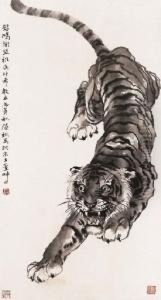Hu Zaobin Paintings
Hu Zaobin was a prominent Chinese painter, educator, and art historian, born in 1897 in Ningbo, Zhejiang Province, China. His artistic and scholarly endeavors spanned a critical period in Chinese history, marked by immense social, political, and cultural transformations. Hu's contributions to the field of Chinese art, particularly in the realms of traditional Chinese painting and calligraphy, have established him as a key figure in the early 20th-century Chinese art world.
Hu Zaobin's early education was steeped in the classics of Chinese literature and art, fostering a profound appreciation for China's rich cultural heritage. He pursued higher education in Japan, a common path for many Chinese intellectuals of the time, seeking to learn from and engage with modern developments while retaining a strong sense of national identity and cultural pride. During his time in Japan, Hu was exposed to a variety of artistic styles and philosophies, which broadened his vision and deeply influenced his later works.
Upon returning to China, Hu Zaobin devoted himself to education and the revitalization of Chinese art. He was deeply involved in the New Culture Movement, which sought to rejuvenate Chinese culture through reforms in education, literature, and the arts, advocating for a synthesis of Chinese and Western artistic principles. Hu's role as an educator saw him teaching at several prestigious institutions, where he influenced a generation of young artists and scholars. His teaching philosophy emphasized the importance of mastering traditional techniques while being open to innovative approaches and ideas.
Hu Zaobin's art is characterized by a meticulous attention to detail and a deep reverence for the natural world, aligning with the classical Chinese aesthetic that views art as a harmonious blend of humanity and nature. His paintings often featured landscapes, flowers, and birds, executed with a refined elegance that captured the essence of his subjects. Hu's work was not only a continuation of the literati painting tradition but also a reflection of his personal search for beauty and truth in a time of turmoil.
Tragically, Hu Zaobin's life and career were cut short when he passed away in 1942, during a period of great upheaval in China due to the Second Sino-Japanese War. Despite his relatively brief career, Hu Zaobin left an indelible mark on Chinese art and culture. His legacy lives on through his artworks, writings, and the memories of those who were inspired by his teachings. Hu's dedication to the preservation and advancement of Chinese art remains a source of inspiration for artists and scholars alike.


